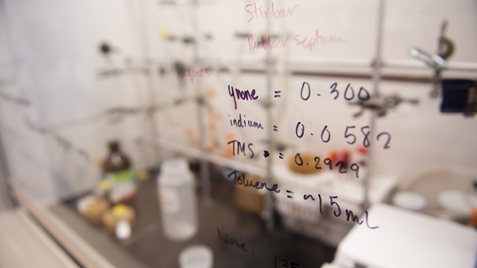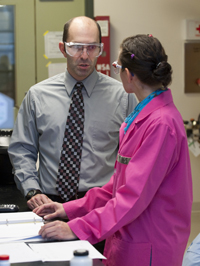

A recently scholarly publication, authored by a Smith chemistry professor and his then-student who is now a Fulbright fellow in Malaysia, analyzes women’s roles in the discovery and development of named organic reactions. It was published in Accounts of Chemical Research and within the first month was one of the publication’s top 10 downloaded articles.
Women’s Roles in the Discovery and Development of Named Chemistry Reactions
/ Originally published in Accounts of Chemical Research, March 2011
Named reactions have a critical place in the history and development of organic chemistry. They help chemists clearly and quickly communicate about complicated transformations, and they honor key contributors in the field for outstanding developments in synthetic or mechanistic knowledge. Beginning with our earliest undergraduate classes in organic chemistry through the most complex graduate courses in our research universities, named organic reactions are an organizing principle that have become part of the fabric of our beloved field. It is impossible to think about navigating the complex world of organic chemistry without the signposts of named reaction.
However, how often do chemists wonder about the origins of these names? Why are some chemists immortalized and others forgotten? Why are some graduate students and postdocs included while other reactions bear only the name of the principle investigator? Unfortunately, discussions of these topics in print are rare. One exception is a fascinating 2010 article by Drahl in Chemical and Engineering News focused on the naming of the Heck (or Mizoroki-Heck) reaction that also addresses the broader question of how reactions are named. Reaction naming is far from straightforward, and no accepted rules exist for naming organic reactions. While most reactions are unnamed, the most practical and widely used transformations merit recognition with a name. Naming rights, however, do not belong to the person who discovered or developed the reaction. Instead, the broader organic chemistry community determines the worthy reactions through subsequent publications and citations.
So, how does a chemist’s name end up attached to an organic reaction? Often, when a reaction is discovered and developed by a single lab, only the director receives credit since many co-workers contribute to the key body of work (e.g., Stille reaction). One exception to this rule is the Diels-Alder reaction in which Diels (the adviser) and Alder (the student) coauthored several papers on their “diene reaction,” and Alder continued to publish on this transformation as an independent researcher. Co-workers are regularly named when their adviser is already recognized for other named reactions (e.g., Corey-Fuchs reaction, Corey-Kim oxidation). Competing researchers who publish simultaneously often both receive recognition (e.g., Buchwald-Hartwig reaction), and reactions discovered by one lab and developed or modified by another often bear two names (e.g., Johnson-Claisen rearrangement). Also, as Drahl mentions in her article, reaction names do change over time.
Recently a question emerged in our lab focused on named organic reactions, “Are any named for women?” After talking to other organic chemists, this simple, yet intriguing question seemed to have appeal beyond the women studying organic chemistry at Smith College, so we decided to search for an answer to this query. We read the named reactions books in our library and even contacted several of the authors of these treatises. These efforts netted limited success; we identified only four reactions named for women: the Goldberg reaction, the Hunsdiecker reaction, the Jourdan-Ullman-Goldberg reaction, and the Piloty-Robinson pyrrole synthesis.

Kevin Shea
This led us to wonder if the lack of reactions named for women related to the historical underrepresentation of women in chemistry or an effort to exclude women from this honor. As a historically male-dominated field, did societal norms of the past make it especially difficult or impossible for women to be recognized for their achievements?
We then decided to modify our initial question in hopes of identifying more female organic chemists with pioneering roles in the discovery of named organic reactions. We hoped this would help us address the issue of women who may have been slighted in the past. Thus, our research question became, “Which named organic reactions were discovered or developed by women?” We were thrilled to discover eleven more women and nine additional reactions in answer to this question. These women played their key roles as undergraduates, graduate students, postdoctoral associates, or research associates on three continents and over the past 75 years.
In addition to simply identifying each woman as a name on a seminal publication, we have made every effort to contact these women and learn more about their lives in chemistry. We were greatly aided by peers, colleagues, and mentors who happily filled in biographical gaps for us. Where possible, we have included details from our correspondence in the descriptions to follow.
On the basis of our research, there is no evidence of gender discrimination in the naming of these reactions. The naming conventions we have outlined above are readily apparent in the names of the reactions that follow. We believe that only one woman in our study, Bianka Tchoubar (responsible for the development of the Tiffeneau-Demjanov rearrangement), was slighted by exclusion from the name of a reaction, and nothing indicates that this was related to her gender.
The accomplishments of the women in this study, described chronologically below, are impressive and worthy of celebration. They should justifiably serve as role models to the current generation of aspiring female organic chemists who will, hopefully, add to the length of this list in the future.
Their study is published in the journal Accounts of Chemical Research.
Julie Olson ’10 majored in chemistry at Smith and is currently a Fulbright fellow in Malaysia. Kevin Shea is an associate professor of chemistry















